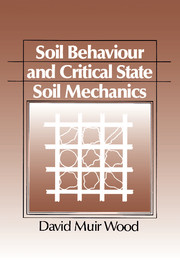Book contents
- Frontmatter
- Dedication
- Contents
- Preface
- Acknowledgements
- List of symbols
- 1 Introduction: models and soil mechanics
- 2 Elasticity
- 3 Plasticity and yielding
- 4 Elastic-plastic model for soil
- 5 A particular elastic—plastic model: Cam clay
- 6 Critical states
- 7 Strength of soils
- 8 Stress—dilatancy
- 9 Index properties
- 10 Stress paths and soil tests
- 11 Applications of elastic—plastic models
- 12 Beyond the simple models
- References
- Index
5 - A particular elastic—plastic model: Cam clay
Published online by Cambridge University Press: 05 October 2014
- Frontmatter
- Dedication
- Contents
- Preface
- Acknowledgements
- List of symbols
- 1 Introduction: models and soil mechanics
- 2 Elasticity
- 3 Plasticity and yielding
- 4 Elastic-plastic model for soil
- 5 A particular elastic—plastic model: Cam clay
- 6 Critical states
- 7 Strength of soils
- 8 Stress—dilatancy
- 9 Index properties
- 10 Stress paths and soil tests
- 11 Applications of elastic—plastic models
- 12 Beyond the simple models
- References
- Index
Summary
Introduction
In the previous chapter, elastic—plastic models for soil were discussed in a general way. Yield loci and plastic potentials were sketched, but no attempt was made to suggest possible mathematical expressions for these curves. In this chapter, a particular model of soil behaviour is described and used to predict the response of soil specimens in standard triaxial tests. In subsequent chapters, this model is used to illustrate a number of features of soil behaviour. This particular model can be regarded as one of the set of volumetric hardening models covered by the discussion in Chapter 4. When the model was originally described in the literature by Roscoe and Burland (1968), it was called ‘modified’ Cam clay to distinguish it from an earlier model called Cam clay (Roscoe and Schofield, 1963). The qualifier modified is dropped here because the modified Cam clay model has probably been more widely used for numerical predictions. The ‘original’ Cam clay model is mentioned in Section 8.4.
The model is described here in terms of the effective stress quantities p' and q which are relevant to the discussion of soil response in conventional triaxial tests. Most of the examples given are for triaxial compression, though it is tacitly assumed that triaxial extension can be accommodated merely by allowing the deviator stress q to take negative values. The extension of the model to other more general states of stress is described briefly in Section 10.6.2.
- Type
- Chapter
- Information
- Soil Behaviour and Critical State Soil Mechanics , pp. 112 - 138Publisher: Cambridge University PressPrint publication year: 1991



